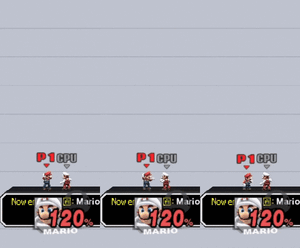Hitstun canceling
Hitstun canceling is a technique introduced in Super Smash Bros. Brawl which is also present in Super Smash Bros. 4 and Super Smash Bros. Ultimate. It is the ability to cancel hitstun (specifically when in tumble) early with an airdodge or an aerial attack. This feature is what enables the technique momentum canceling to be performed.
In Brawl
In Brawl, hitstun canceling is very effective. For any attack strong enough to put the player into tumble, said player can cancel hitstun with an airdodge after only 13 frames, regardless of how much hitstun would have otherwise been dealt. Alternatively, after 26 frames, the player can cancel hitstun with an aerial. As a result of this feature, combos are notoriously difficult to perform in Brawl; however, due to the high ending lag of airdodges in the game, it is still possible to get followups out of attacks that put opponents into tumble.
Once hitstun has been canceled, one can initiate any action that they otherwise would be able to perform in the air, including initiating a fastfall, the core principle of vertical momentum canceling. The only exception to this is sideways movement through the air, which still cannot be performed until the hitstun would have ordinarily ended (seemingly to prevent characters like Jigglypuff with a high air speed from surviving horizontally far longer than usual); however, this can be circumvented by jumping after the lag from the action used to cancel the hitstun ends, which is one way of performing horizontal momentum canceling.
Hitstun canceling is one of the most controversial additions to Brawl, with detractors criticising it for undermining the reward of characters' advantage states by leaving them impossible to truly combo opponents with moves that deal anything beyond very low knockback. This eliminates the comboing ability of characters that relied on higher knockback moves with faster mobility to combo (Captain Falcon being the most prominent example, with Jigglypuff also suffering severely), allows characters to survive longer than intended through momentum canceling, and significantly increases the chance of getting punished for landing a hit. While some players argue in support of the mechanic, such as by stating that players should have to successfully read their opponent's actions to get successful followups, it is generally viewed the mechanic as a negative addition to the game, due to severely slowing down the pace of matches. As such, mods usually remove the mechanic unless they intend to keep Brawl's engine intact, such as Balanced Brawl, and all major mods except the aforementioned have removed the mechanic completely.
In Smash 4
Hitstun canceling was significantly weakened in Smash 4. A player can now only cancel hitstun with an airdodge or aerial after 40 and 45 frames respectively, and only if the current launch speed (i.e how much of the initial knockback speed is still present) is below 2.5 and 2 respectively. This has the effect of making hitstun cancelling impossible for attacks dealing 100 units of knockback or less, and causes the effect to scale with knockback unlike in Brawl. As a result, combos are easier to perform than they were in Brawl, and momentum canceling is practically impossible. Also worth noting is that while hitstun itself does not consider additional launch speed from the gravity penalty, hitstun canceling indirectly does (since current launch speed, not initial knockback value, is used to scale the effect). As such, fighters with low gravity have slightly stronger hitstun canceling than fighters with high gravity.
In Ultimate
Hitstun canceling in Ultimate retains the same parameters as Smash 4, but due to the effect of balloon knockback, most hitstun and launch speed wears off by the time one is able to attack or airdodge, significantly mitigating its effectiveness, and making cancelling with aerials practically impossible. Furthermore, the new limitations on airdodging mean that airdodging to hitstun cancel is a significant hindrance to a character's ability to avoid edgeguarding attempts or follow-up attacks. However, the technique still has some use against moves with set knockback, due to them retaining pre-Ultimate launch physics, and can also be used against grounded meteor smashes, due to them effectively dealing more hitstun than usual as in previous games.
